The Architecture of Nothingness: Analysing Frank Lloyd Wright’s Unity Temple
The Architecture of Nothingness: Drawing the Drawings
As architects we have learned to read drawings almost instantly. At a glance we see what the spaces feel like, what it will be like to move around the building and perhaps even get a sense of the appropriateness of the structure. This ‘presentational’ way of being able to instantly read complex three-dimensional space is shared by artists and sculptors, but it is very different to most other cultural systems. In language, literature, philosophy, poetry, mathematics, even music, ideas are not read holistically in the moment but are built up ‘discursively’, to include time. In literature we have to sit with a book for hours, in music we have to listen carefully to a symphony as it unfolds, in such instances we have to remember the beginning to make sense of the end. Many of us will have faced clients or planning committees that have failed to understand the holistic nature of design. Architects understand this holism, but when it comes to architectural journalism, the holistic nature of architecture can be something of a challenge as it calls on the architectural critic to appraise a ‘presentational’ discipline in a ‘discursive’ mode.
Like many of us, as a student, I was totally wrapped in the joy of designing without having any real understanding of how I was doing it. But then, shortly after completing my education, something turned up that made me start to ask questions about the whole process of architectural design. Ultimately, those question boiled down to just one: how are we to distinguish between good and bad design? The excavation of the many layers within that question has taken decades to unearth but one of the essential tools that I needed to help in those archaeological digs turned up almost as soon as I asked that first question. I had been applying to universities in the USA as a way to address the nature of design, when I was invited to my old school to have lunch with Geoffrey Baker, a new reader that had been appointed to lead a small research team. I was reluctant to return to my old school but Geoffrey and I got on so well that the lunchtime conversations ran late into the evening. Like myself, Geoffrey loved to design. He had been short-listed as a Rome Scholar but, in addition to his design abilities, in his PhD he had developed a technique of diagrammatic analysis that created a method to investigate the ‘presentational’ reality of architecture in a ‘discursive’ way. I decided to forget about trips to the USA and instead signed up for what turned out to be four-or-five-years of research.
The great thing about Geoffrey’s technique was that it was able to open up the inner workings of a building, without losing any of its wholeness. I came to think of those diagrammatic techniques as the architect’s equivalent of Galileo’s telescope or the microscope used by Pasteur. Reading Geoffrey’s PhD thesis on Le Corbusier was for me an eye-opening experience. [1] I had read many books about Corb, but none of them had explained his buildings as Geoffrey’s technique was able to do. Reading his analyses gave me the same joy as designing – in a sense, designing in reverse. It is that same analytical technique that I used to support the arguments in The Architecture of Nothingness [2]; let me explain how those analytical tools are used.

The first and most important point to realise is that the technique is not seeking to explain how the building was designed: that is a totally private affair between the architect and her building. Secondly, we are not really interested in what the architect or any other person has to say about the building, nor are we interested in our own opinions about the building. As the analyst of the building, we are only interested in the building as it is experienced, how the different parts of the building are able to affect us, how the forms interact to open spaces to light or how they visually or physically direct movement in and around the building. In other words, we simply want to explore the building as it is.
Generally speaking, in an analysis, it is easiest to start with what we might consider the ‘generic’ form of the building in context. From the analyses included in the book, the generic varied. For example, in the analyses of the Winslow House elevation, the generic I used was the prototypical elevation of a ‘house’, the sort of house a child might draw. In other analyses, the site suggested linear, or courtyard generics, in the example included here for Unity Temple, a centroidal generic was used. Having established the generic starting point, subsequent diagrams make adjustments to the generic as it is compromised by site forces, environmental conditions, entrance sequences, etc. There are only a few guidelines to help move the process along. Firstly, each diagram should describe just one design decision, so for example, if one architectural form achieves three different design objectives, then three diagrams will be used to explain each one of those points in turn. This technique is thus the polar opposite of the photographic image that shows everything but explains nothing. Secondly, diagrams should not include architectural elements that have not been explained in previous diagrams. Given that we are describing an holistic scheme in a linear format, it can sometimes be quite challenging to find a sequence that reads comfortably, but if we can achieve this, slowly the inner logic of the design will unfold. Thirdly, if you cannot see immediately why a specific form has been used, replacing it temporarily with an ‘alternative ordinary – most obvious’ solution might open up an appropriate reason for that particular form. Finally, if you repeatedly cannot explain the role played by some of the forms in the building, then you may be looking at a poor design.
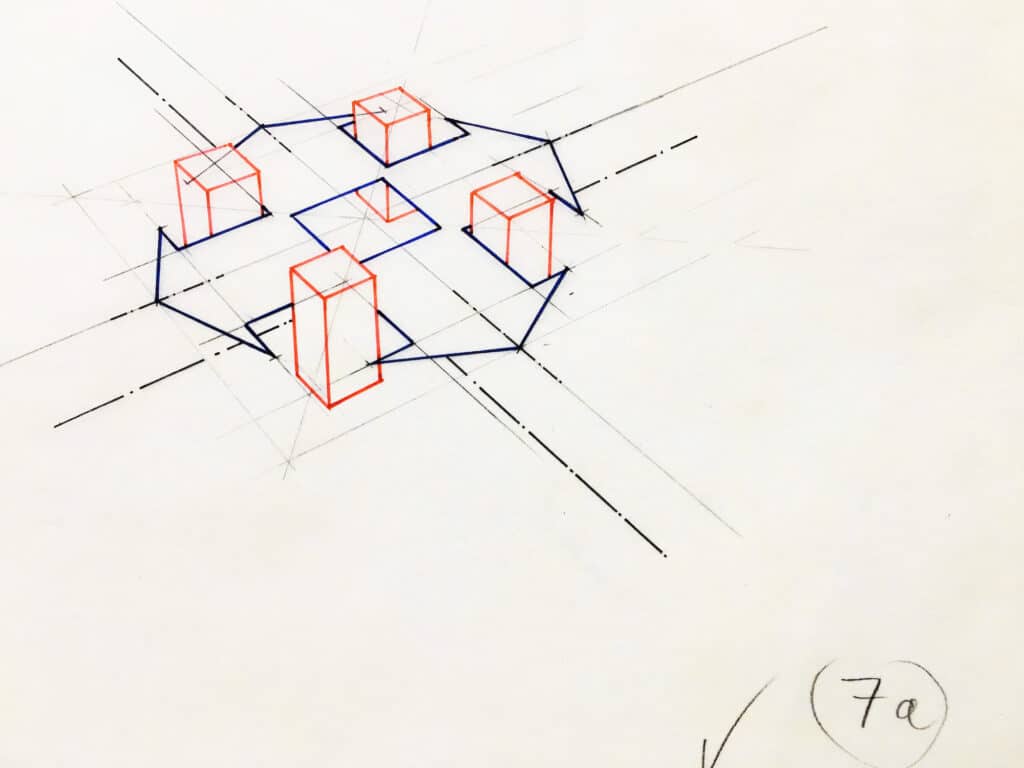
The innocence of a design analysis can be quite disarming, viewed superficially, it can all seem rather obvious and even simplistic, but to the discerning it will be compelling. On many occasions I have been truly delighted by the discoveries that I have made within a work. For example, although I have loved the Robie House since I first read about it in the sixth form at school, I only came to fully understand how Wright had achieved some of his design moves forty years later when I prepared the analyses for the book. Similarly, with the Winslow House, it was only after the book was published that I fully realised the importance of one of Wright’s decision to leave transoms out of some of the ground floor windows. I am still amazed that such simple decisions could have such powerful consequences: that’s the power of analysis.
The drawings that appear in the book, were prepared by my wife Alicja Andreasik Lyons and myself. Sitting at the same desk, we drew them over the spring and summer of 2018, they took us much longer than we anticipated, even though all the analytical work had been done beforehand. Generally, the drawings fall into two categories, the simple line diagrams described above, that were to a large extent drawn by myself and the rather beautifully prepared images of the finished buildings drawn by Alicja. Let me first say a few words about the drawing of the diagrams. The original analysis of Unity Temple had been prepared many years earlier, as part of lecture for my students. The idea that Wright had redefined architecture in the first part of his career, by creating spaces that flowed into each other and out over terraces to the city or landscape was already well established in his early ‘Prairie House’ language. The reason I wanted to analyse Unity Temple was because I was curious to see whether he could realise the same spatial dynamic whilst working with a more or less solid building form. As it happened that is precisely what he achieved.
Before you can start an analysis, it is necessary to have a good set of plans, sections and elevations of the building. I was lucky enough to have those and also copies of some of Wright’s own drawings that Ernst Wasmuth had published in Berlin [3], to coincide with Wright’s visit to Europe.
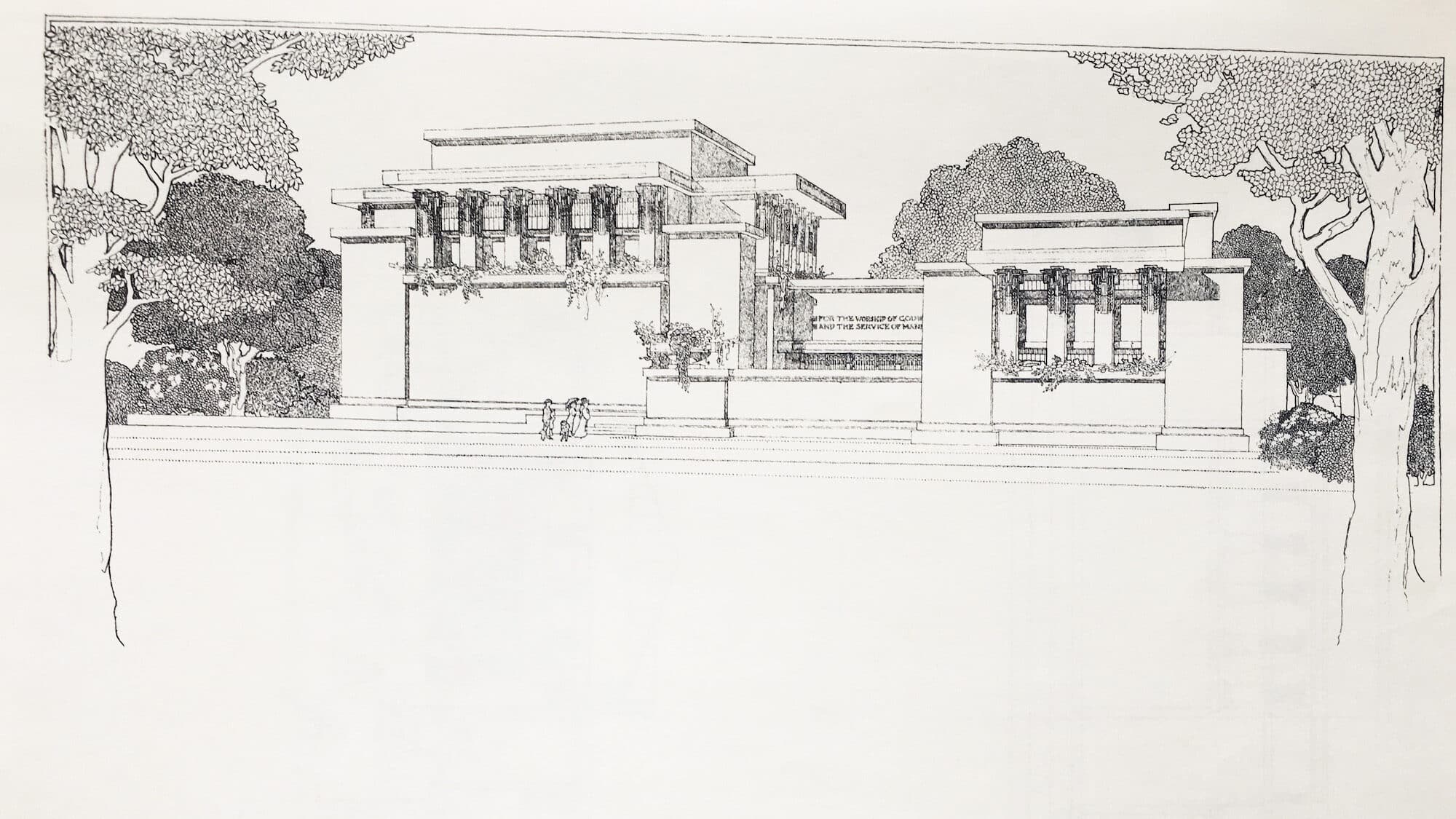
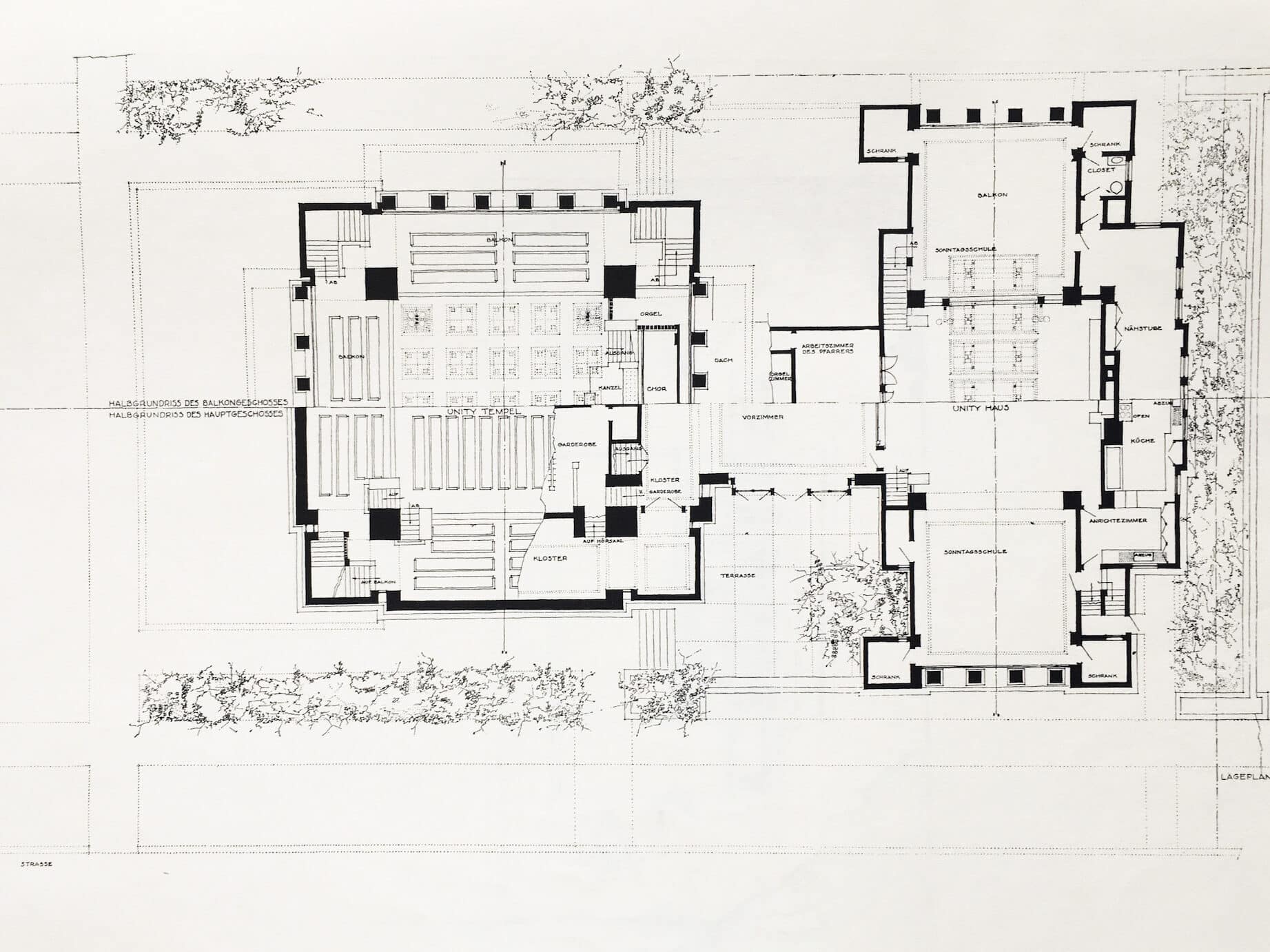
From those base drawings I created a simple three-dimensional drawing of the centroidal generic form as it sat on the site. That first set of analytical diagrams were hand-drawn with a soft pencil on my favourite detail paper – C300 – differing line thicknesses were simply achieved by using a heavier pencil line. In those days, the sketch diagrams were copied on to acetates for projection. However, when it came to the publication of the book, those early pencil drawings had to be set-up more carefully. Intuitively, I had sketched the aerial view of the generic, such that I could explain the internal movement of the spaces, but it turned out that the three-dimensional aerial view was neither axonometric nor isometric but some form of three-point perspective.
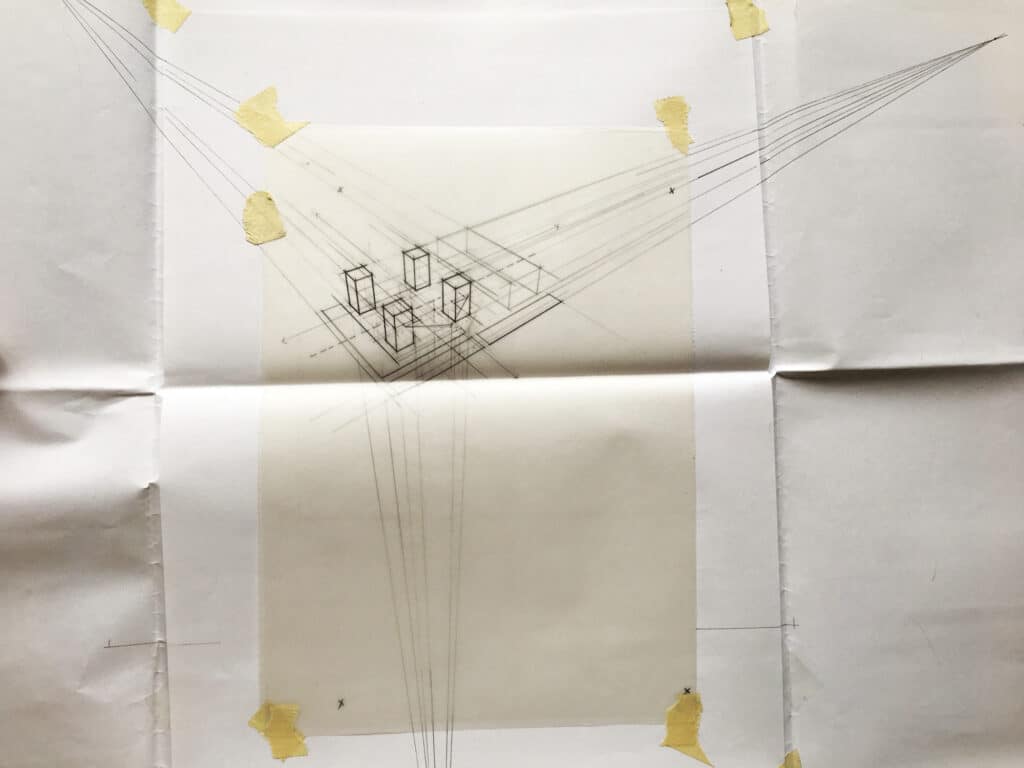
Alicja stepped up to re-cast a new version of the base drawing in perspective. Although the Unity Temple diagrams appear in the last chapter of the book, they were actually the first that we prepared, so we were experimenting with size, scale and line weights, pens and paper, and even with the style of arrows to be used. Actually, setting up arrows by hand in perspective turned out to be one of the most tedious jobs. The diagrams of Unity Temple went through several iterations, each of the final diagrams were about 135mm square reduced to 50x50mm in the book. These first diagrams were drawn as sets of four, ready for the book, on A3 sized tracing paper sheets, using 0.5 and 0.3 Staedler Liner pens, though almost all the other drawings in the book were drawn separately onto A4 sheets of the same C300 detail paper that I had used for those early pencil drawings. This paper is less forgiving of mistakes when drawing with a pen, but the ink dries more quickly than on drafting film, so that was our preferred option. The drawings were then scanned into Photoshop and set up in InDesign with titles and annotations.
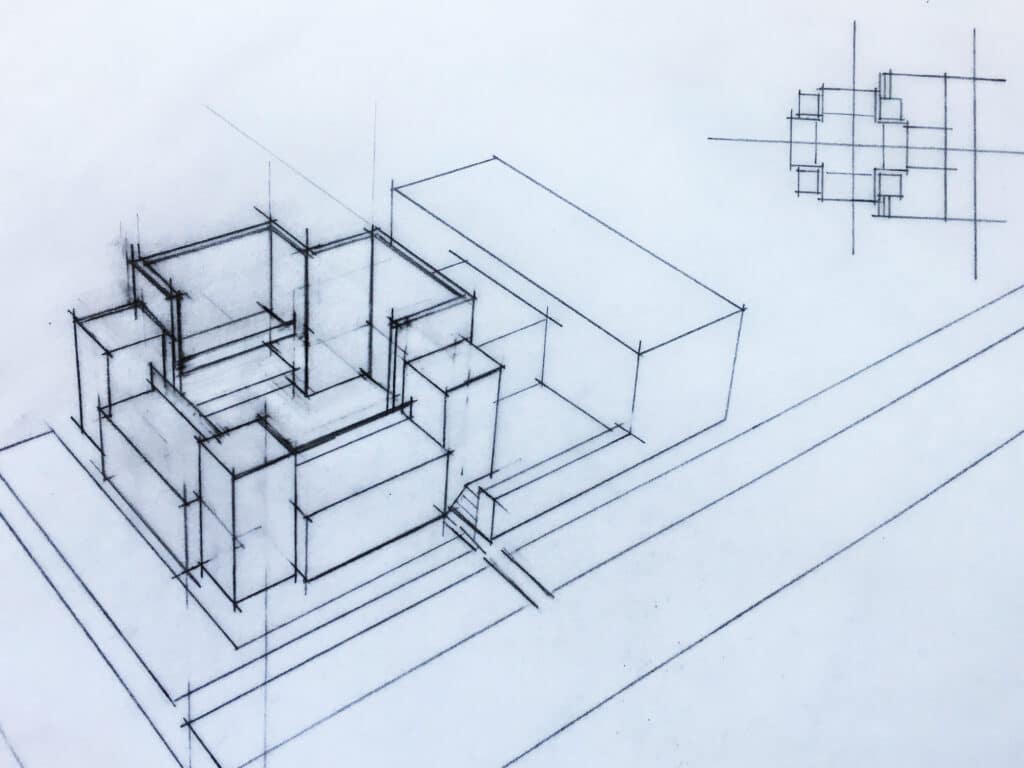
In Geoffrey’s books, he would often use photos of the finished building at the end of an analysis but for various reasons we decided that it would give the book a greater sense of unity, if we prepared all the illustrations by hand. Alicja had been educated in Poland and in Poland a good portfolio of drawings was a necessary part of entry into architectural education. Furthermore, for the first three years of architectural studies in Poland, twice weekly drawing classes in Beaux Arts style studios were part of the curriculum. Although we had never previously created illustrations for a book, we had worked together on office drawings and annual Christmas cards, so I knew that Alicja had developed a lovely, patient and balanced hand, when it came to drawing. The ‘pointillist’ drawing style we had used before, but Alicja seemed to take it to new levels in these illustrations. Her first drawings using this style for the book were also, as it happens of Unity Temple. She worked over photos I had taken when I visited the building. These early drawings were again about 120mm square, but as more detail was added in later illustrations, larger drawings were preferred. Also, as the detail was increased the pen sizes decreased, for the first Unity Temple drawings she was using 0.5mm pens, but by the time she decided to tackle the detailed brick courses on some of the later illustrations, she was using pens as fine as 0.05mm. The patience that Alicja needed to create the detail in these drawings was almost zen-like but it is a style of working that she enjoys and they make a huge contribution to the quality of the book. We hope you enjoy.
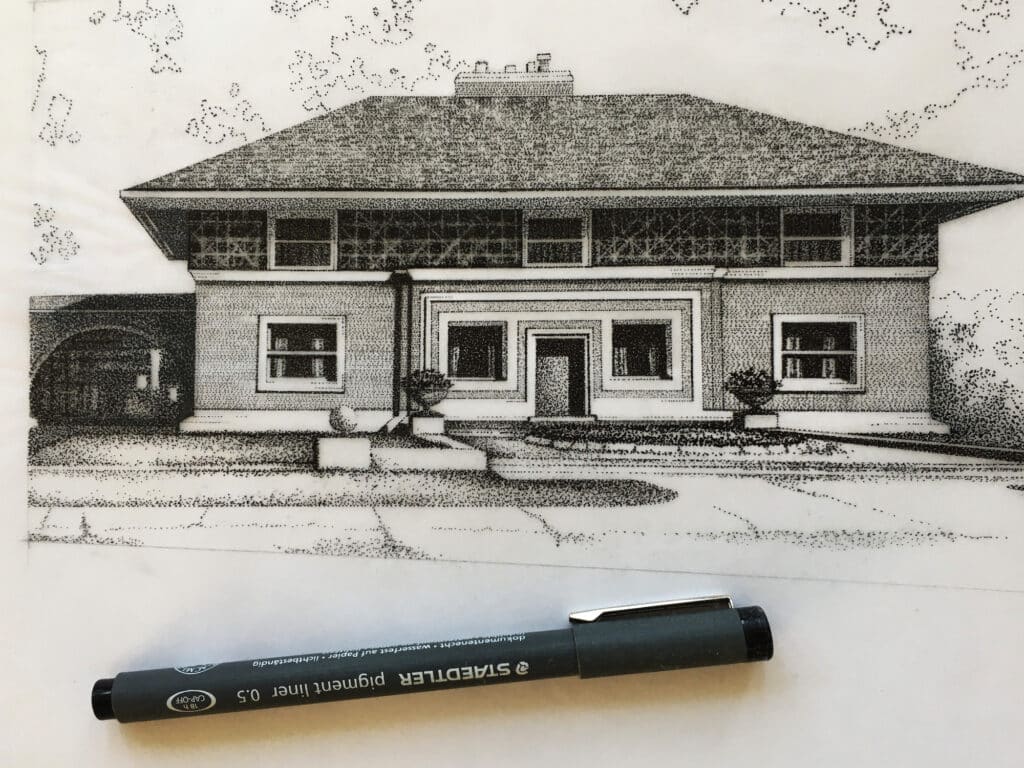
Excerpt (pages 210–216) from ‘Beauty as Reconciliation’, chapter 7 of The Architecture of Nothingness.
UNITY IN ARCHITECTURE
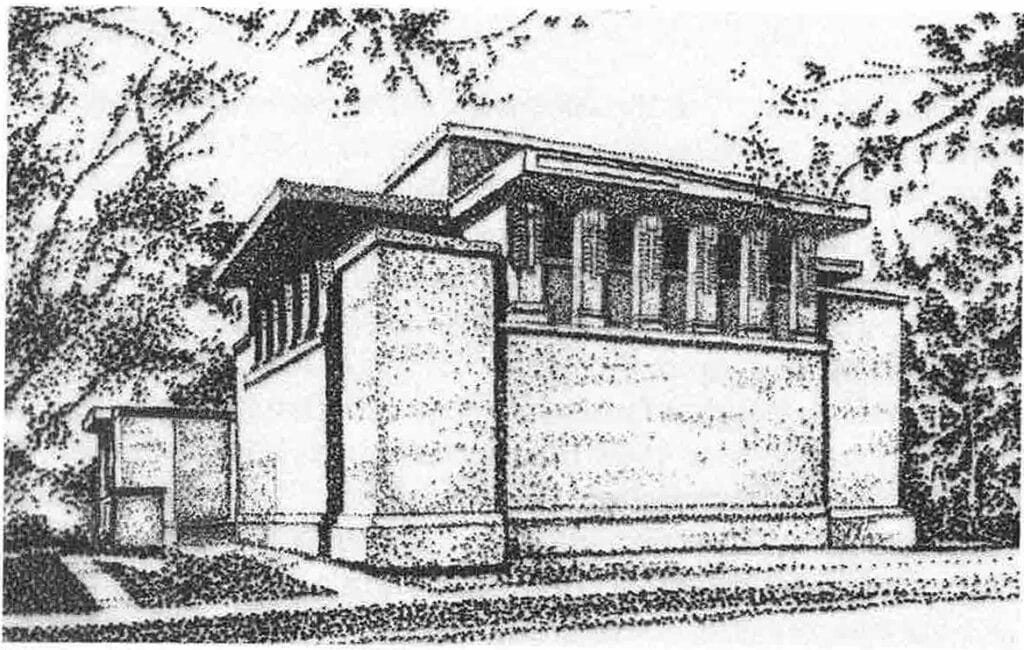
In architecture we had such a step forward when Frank Lloyd Wright was able to ‘destroy the box.’ We have already seen examples of how this grew out of a preoccupation with the reconciliation of centre and expansion that was evident in the Winslow House. However, as we saw fifteen years later in the Robie House, this had grown into the realisation that a preoccupation with centre and horizontal expansion, or experientially, as dwelling within the hearth of the building, being set against the movement out into the wider world, could be more fully expressed as a reconciliation of solid and void, inside and outside, privacy and community. Although we get hints of the more mature ideas in several of his earlier buildings, the evolution of that idea was a slow process. From his own perspective, he tells us that this idea was first fully realised in his designs for Unity Temple, in Oak Park, Chicago, in 1906. In Unity Temple, a fitting title for the place where this event took place, he successfully reconciled and showed there to be a unity between mass and space; earth and sky; those two great polar opposites that had remained irreconcilable throughout the entire history of architecture (Figures i to xvi).
Frank Lloyd Wright’s family had connections with the Unitarian congregation in Oak Park, so when in June 1904 the timber church burned down, Wright was approached to take on the commission for the new building. As Wright remembers this in his autobiography, ‘The first idea was to keep a noble room for worship in mind and let that sense of the Great Room shape the whole edifice. Let the room inside be the architecture outside.’ [4] He argued in his autobiography that the square plan of the temple was justified for economic reasons, because it allowed the concrete shutters to be reused on each of the four sides, but more importantly, the square plan gives him a much more unified space, symbolic of the organic unity he saw in nature [5] and in the democratic ideal he so passionately pursued (fig. ii). ‘The Chinese philosopher Laotze preached the sense of individuality as a reflex of the organic unity of the Cosmos: the true source of human power, the all-pervasive “state of becoming.” Our own democratic ideal of the social state stems originally conceived as some such unity. That is to say, democracy was conceived as the free growth of humane individuality, mankind to function together in Unity of spirit.’ [6]
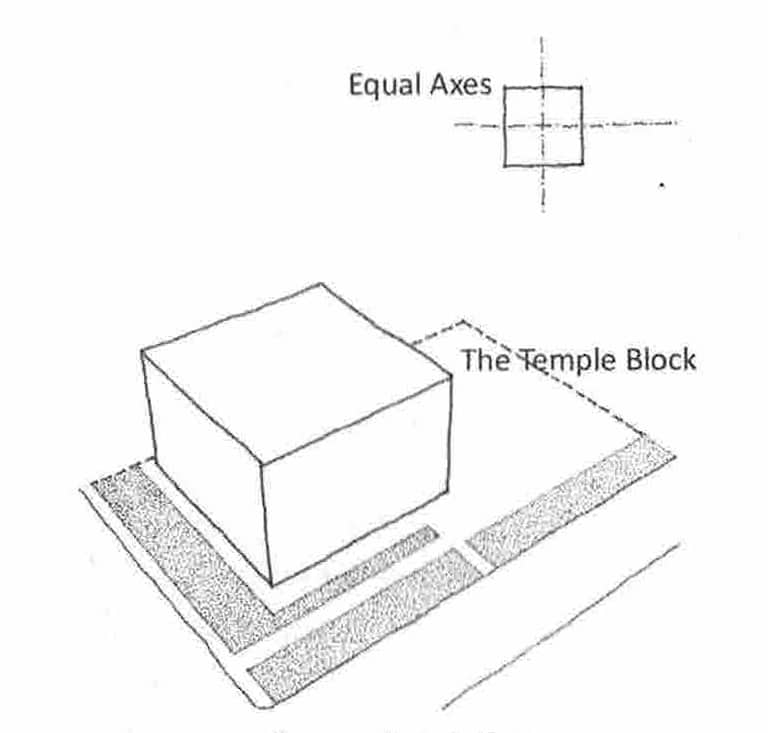
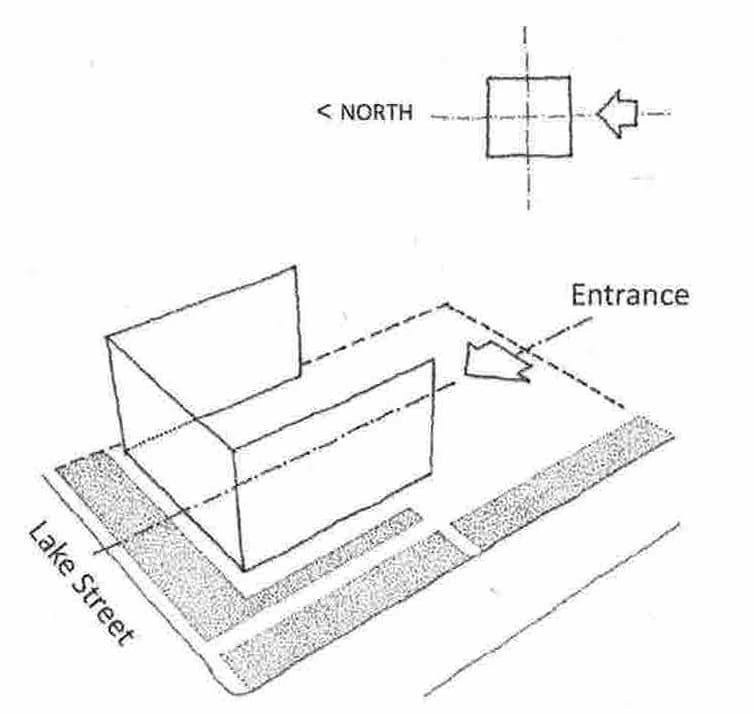
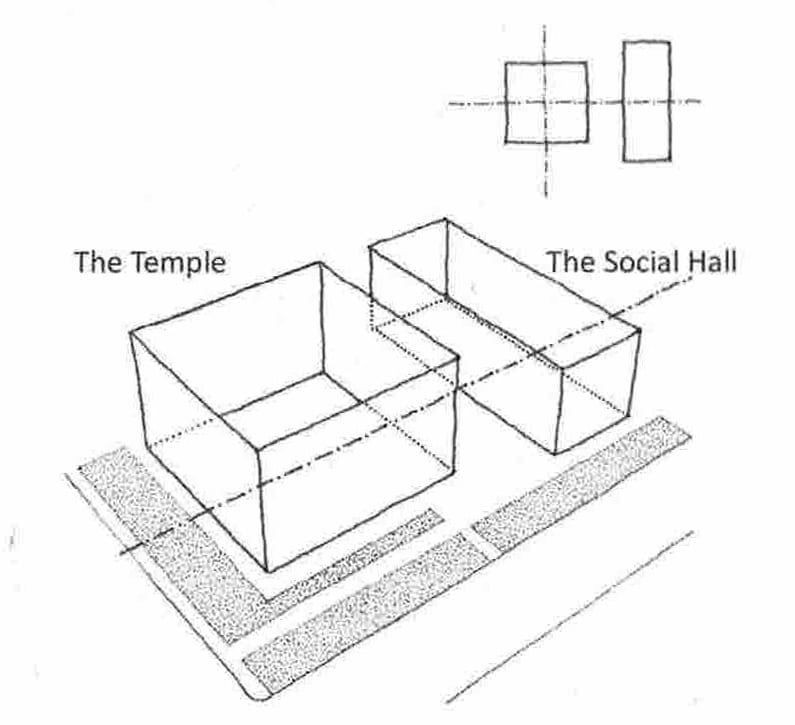
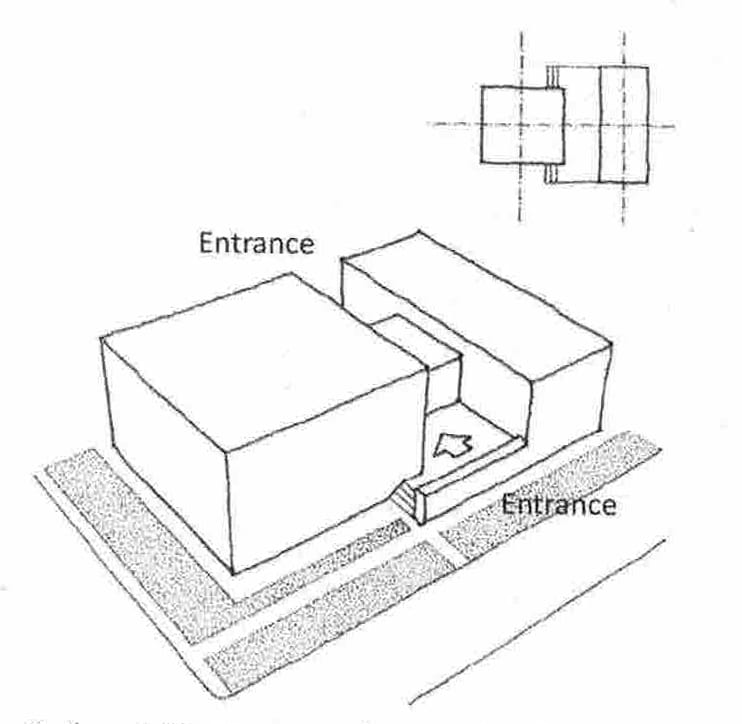
The site itself was noisy, with roads on two sides, so Wright decided to keep the form of the temple closed on three of its sides and enter the space from the south of the plot (fig. iii). In addition to the temple the Unitarian Church had secular activities, which needed to be incorporated: entertainment, celebratory meals and Sunday school. Wright was reluctant to incorporate these in the temple block since ‘it would spoil the simplicity of the room.’ So he decided to put these activities in a separate block to the south of the site, which they called Unity House (fig. iv) The two buildings were entered from a lower block, which served to link them together. Linking these two blocks proved the most difficult part of the design; he says in his autobiography that he made some thirty-four separate studies of how these two elements could be brought together in a coherent form. [7] The problem that he faced was that he did not want the secular block to challenge the primacy of the temple in the scheme. Ultimately, the solution was to link the two elements by wrapping the entrance terrace around the edge of the temple, the horizontality of this third element
effectively binding the separate parts into a coherent whole. The proportions adopted for the two major elements were also very important in the overall design. Compositionally the secular block was purposefully kept quite low and squat thus allowing the temple block to rise above the Unity House and maintain its pre-eminent position in the composition (fig. v).
Internally the arrangement of the temple is most interesting for us to explore. The focus of a Unitarian church is the pulpit. In Wright’s design for the church in Oak Park, the pulpit is placed on the entrance side of the temple, on the axis linking the two blocks together (fig. vii). Somewhat unusually, Wright then sets up an entrance sequence that brings the congregation in at a lower level, circulating them in a cloister below the temple and giving them access to vertical circulation shafts, in the corners of the temple block (fig. viii). Thus the congregation could enter the cloister without having to walk past the pastor, but would be able to see into the temple from below and would be able to find their way to their seats discretely. To leave the auditorium, doors beside the pulpit would be opened; the congregation would then be able to leave, without turning their backs on the pastor, and would find themselves in the entrance lobby where they first started. Seating on the floor of the temple auditorium is arranged simply to face the pulpit and on the sides of the auditorium arranged as balconies swung between the great corner towers (fig. xi). Four hollow square columns in the inner corners of the towers form the main structural elements of the temple block and ducts run within these towers to ventilate the large auditorium space. Lighting within the whole complex is from above. Above the upper gallery on each side of the auditorium clerestory lights are fitted under a spreading cantilevered slab and over the heart of the auditorium, a grid of roof lights allows light to pour into the centre of the space (fig. vi and fig. xii).
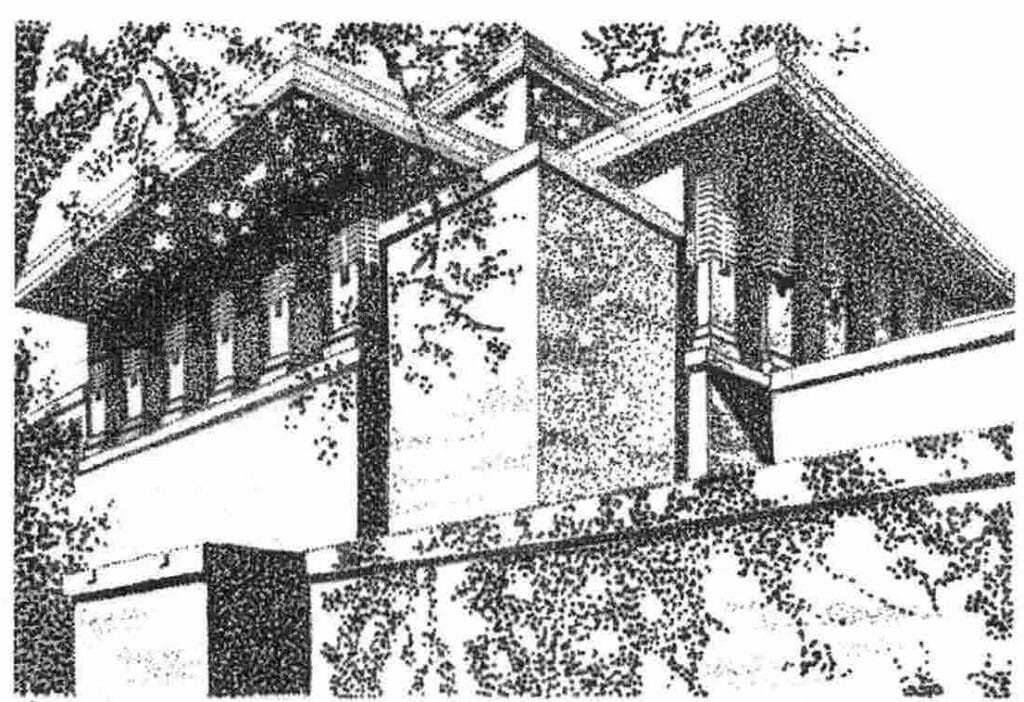
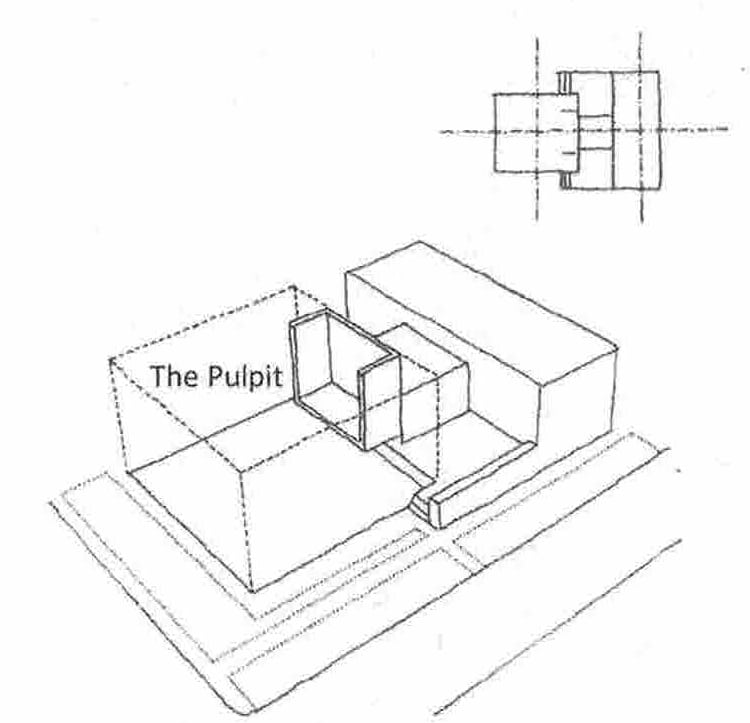
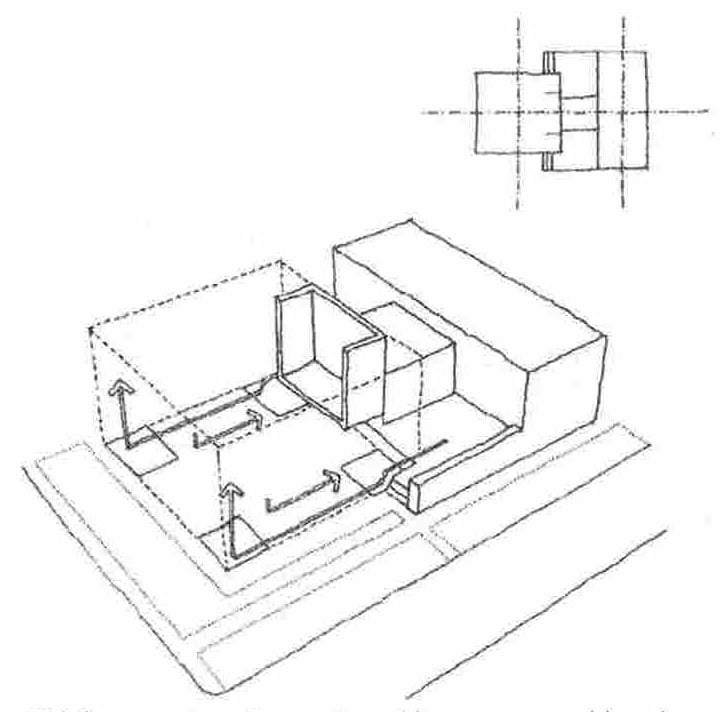
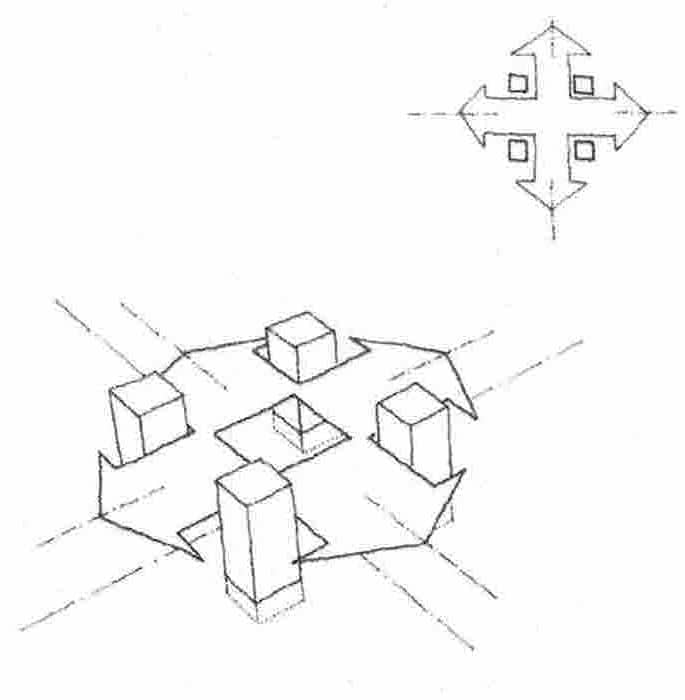
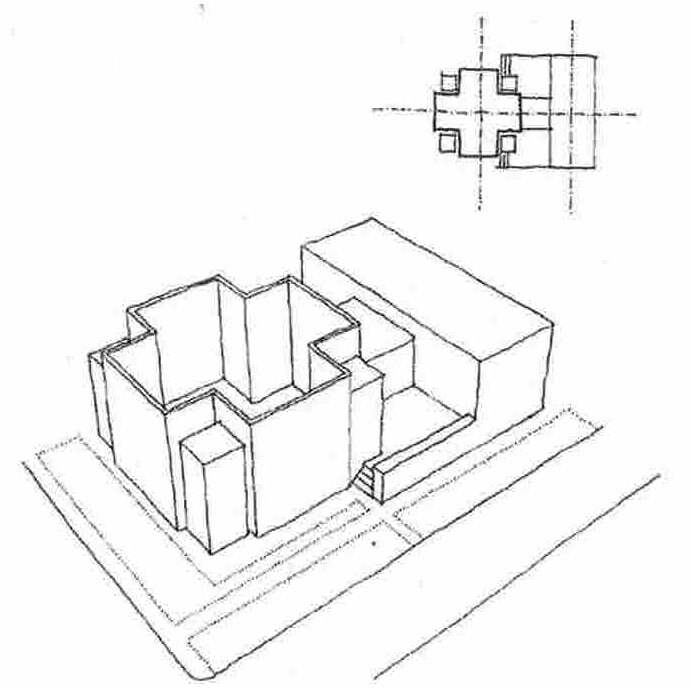
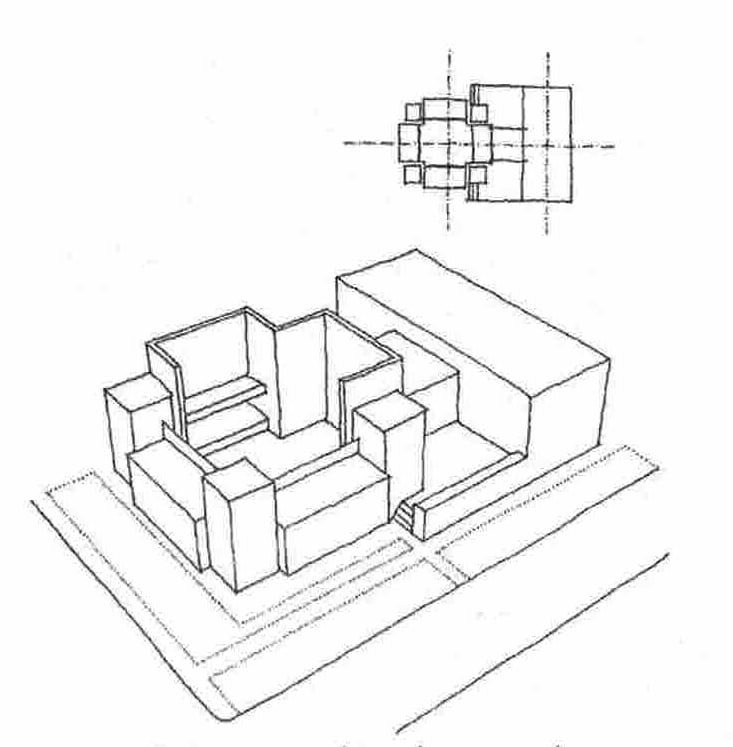
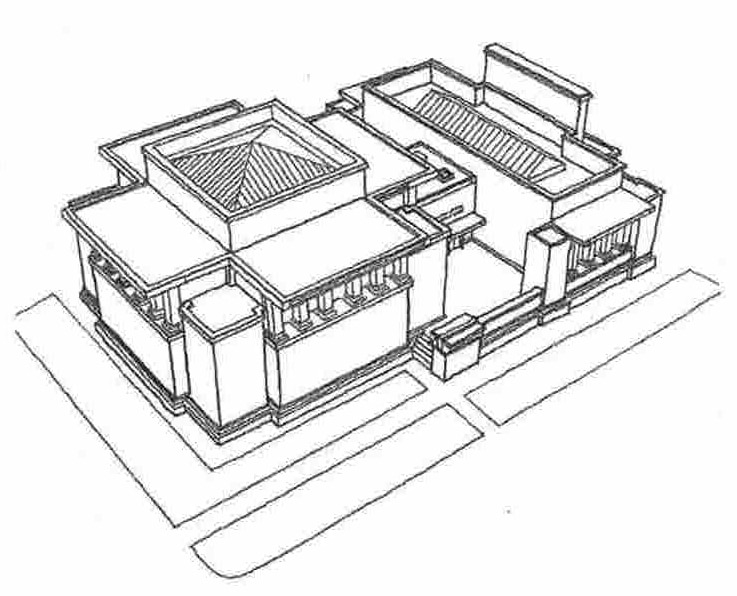
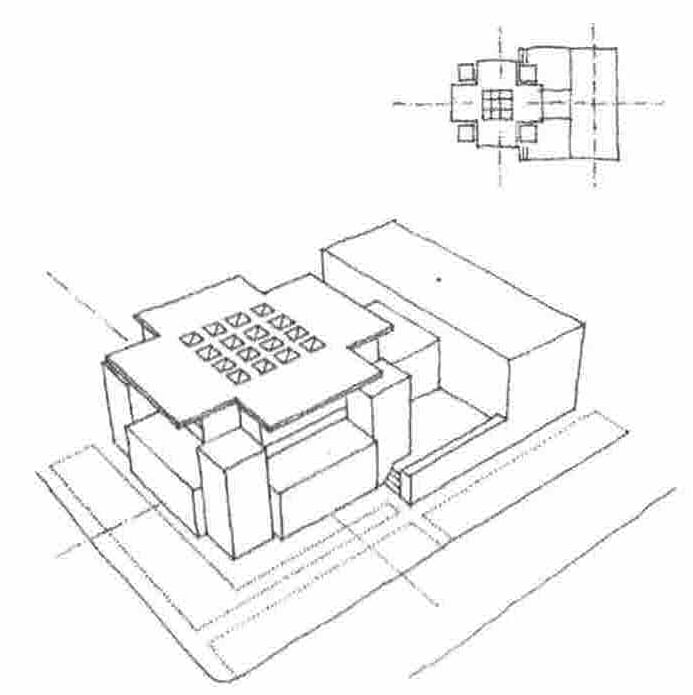
THE RECONCILIATION OF MASS AND SPACE
So far in our discussion of Unity Temple we have dealt primarily with the directly pragmatic issues that arose in the building. The most important aspect of this building, however, is the way that Wright was able to capture deeper values, related to his understanding of the organic unity of life. ln this building, Wright set out to demonstrate a reconciliation of inside and outside, solid and void, those two great polar opposites that had dominated architecture since mankind first pulled a stone to the door of his cave. Wright was preoccupied with this reconciliation throughout his career and realised it in many great buildings by judiciously dissolving inside spaces, through partially glazed walls, into external terraces and the landscape beyond. [8] Interestingly, however, it was here in Unity Temple, a totally internal environment, that Wright felt that he had achieved this resolution for the first time. ‘There perhaps is where you will find the first real expression of the idea that the space within the building is the reality of that building. Unity Temple is where I thought I had it.’ ‘You will see, there in Unity Temple . . . the sense of the Great Room coming through – space not walled in now but more or less free to appear.’ ‘In Unity Temple you will find the walls actually disappearing; you will find the interior space opening to the outside and see the outside coming in.’ [9]
Wright referred to this idea as the ‘destruction of the box.’ [10] At the large scale of the building, we see it in the basic disposition of the elements. Limiting our discussion to the temple block, we can see how the four corner towers pull themselves clear of the main mass and almost seem to skewer themselves to the ground (fig. ix). These four elements thus form the solid anchor to the block and allow the central temple space to push itself out between these anchored positions (fig. x), The composition both grounded and freed thus seems to pulsate between these contradictory forces, with the one pushing and pulling against the other. At the upper level of the temple element, the solidity of the envelope breaks down into lead-lighted glazing, articulated externally by six columns on each façade. In a very real sense at this level, the interior is allowed to break out and light is allowed to pour-in. Almost as if to underline this spatial movement, the roof at this point stretches out in a cantilever structure to form a canopy to the clerestory.
At the scale of the major building elements, we can see that Wright was able to create the impression of mass and space interpenetrating and oscillating with each other, but even when we examine the solid elements In this composition, we find that the same principles are being demonstrated. Internally, four solid towers penetrate the major temple space and the space between these is layered with balconies. When we examine these corner towers, we find that their solidity is challenged by the way that Wright has decorated them. Instead of using panels on each surface of the towers, as was traditional at that time to reinforce
each of the surfaces, [11] the panelling is allowed to frame the corner of the tower, thus effectively merging two surfaces into one (fig. xiv). The effect that this has is that it breaks down the corners of these elements and seems to bring space into the solidity of the towers. The technique is repeated on the leading edges of the balconies (fig. xv) and on the reveals of the roof lights above (fig. xvi). The overall effect is that mass and space start to blend into one another, even within the solid elements of the design. The form of the building thus begins to appear less substantial and one is left wondering where space finishes and where mass begins.
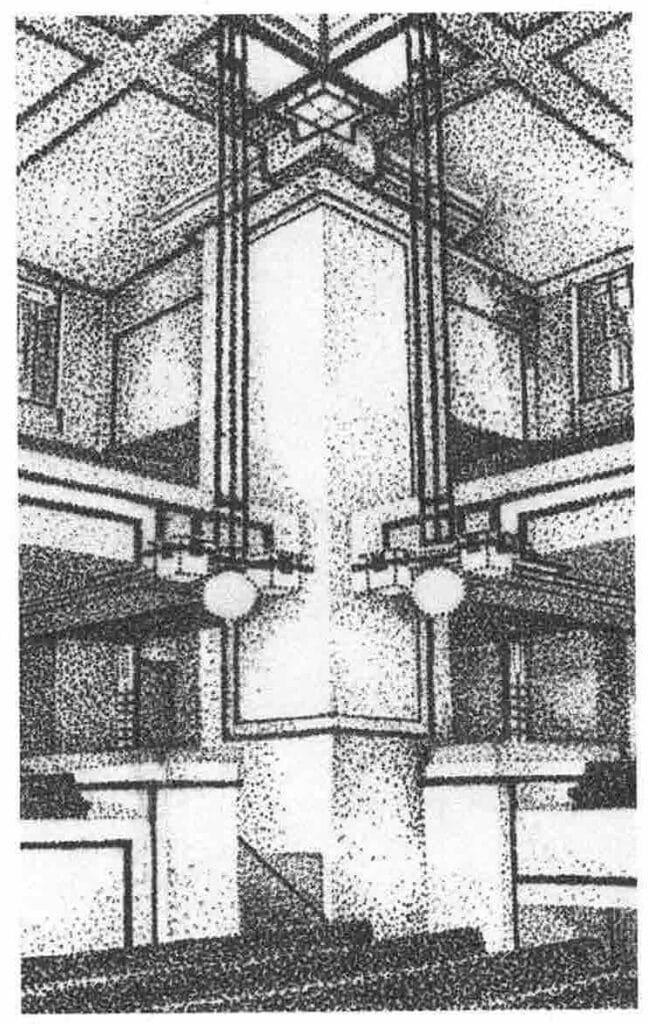
Figs: xiv–xvi: Mouldings are used to dissolve the corners of the stair towers, the edges of the balconies and roof lights, creating the illusion that form and space merge into each other.
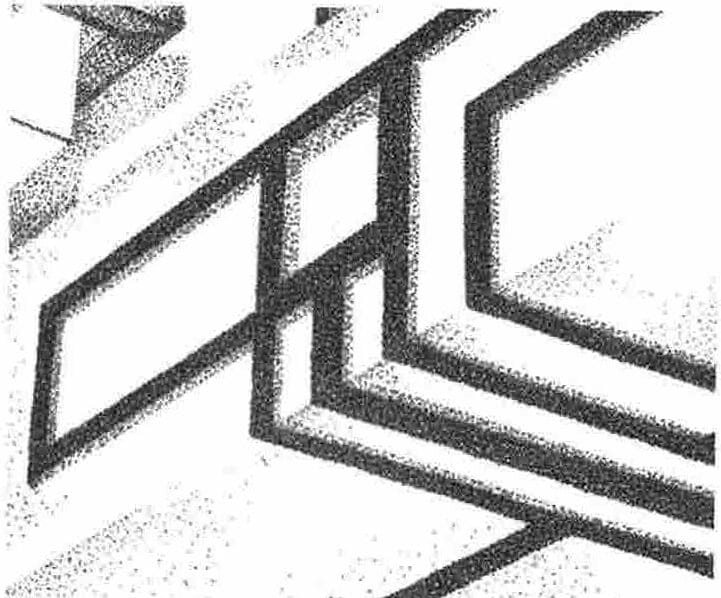
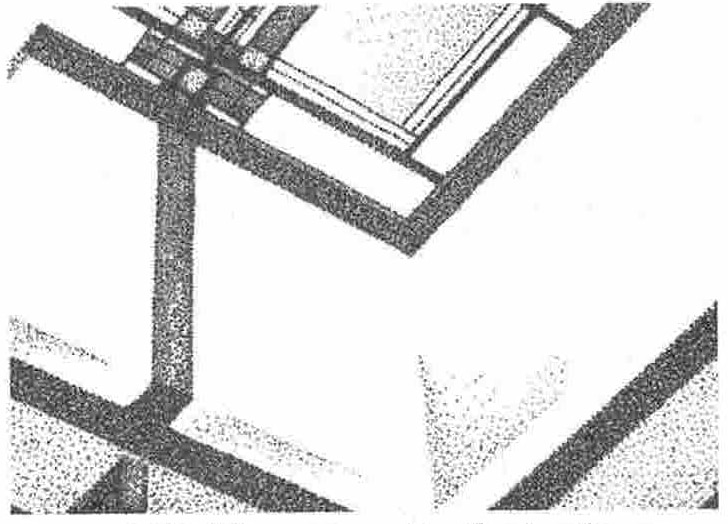
Notes
- The PhD was later published in two books: Geoffrey H. Baker, Le Corbusier: An Analysis of Form (Van Nostrand Reinhold, 1984), and Geoffrey H. Baker, The Creative Search (E and FN Spon, 1996).
- Frank Lyons, ‘The Architecture of Nothingness: An Explanation of the Objective Basis of Beauty in Architecture and the Arts’ (Routledge, 2019).
- Frank Lloyd Wright, Drawings and Plans of Frank Lloyd Wright: Early Period (1893-1909), republication of the work originally published by Ernst Wasmuth, Berlin 1910, (Dover Publications, 1983).
- Frank Lloyd Wright, An Autobiography (New York, NY: Duell, Sloan and Pearse, 1943), 154.
- It has been argued that Wright’s architecture in part derives from his early engagement with the toy blocks developed by the Austrian kindergarten teacher Frederich Froebel who developed the toys to encourage children to understand the holistic organisational structure of natural forms. For an excellent examination of this subject see: Richard MacCormac, ‘The Anatomy of Wright’s Aesthetic’, Architectural Review, no. 143 (February 1968).
- Frank Lloyd Wright, The Living City (New York, NY: Horizon, 1958), 45.
- Lloyd Wright, An Autobiography, 158.
- See the discussion of the Robie House, Chicago, 1908, in chapter 5.
- Frank Lloyd Wright, ‘The Destruction of the Box’, from an address to the Junior Chapter of the American Institute of Architects, New York City, 1952. Taped and typed; corrected by FLLW. Published in Frank Lloyd Wright, Writings and Buildings, selected by Edgar Kaufmann and Ben Raeburn (New York, NY & Scarborough, Ontario: Meridian Books, 1950), 284.
- ibid., 284–289.
- Indeed Frank Lloyd Wright used this technique to emphasise the panels separately, for example on the exterior of the Hunt House, La Grange, Illinois, 1907.

– Elizabeth Hatz